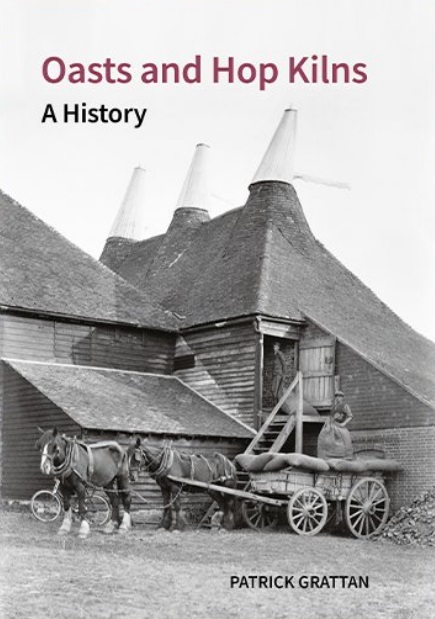Oasts and Hop Kilns: a history
Oasts and Hop Kilns: a history, by Patrick Grattan, Liverpool University Press for Historic England, 2021, 182 pages, colour and black and white illustrations, hardback.
The built heritage connected with the UK brewing industry is formidable, although regrettably much diminished due to technological and other factors. The businesses reached their commercial peak around 1900. Since that time the development sites of once-great breweries and the numerous pubs and inns they served have become more valuable than the gains to be made from brewing and inn-keeping. Despite extensive demolitions, some of the best breweries have survived or have been converted to other uses, and the same can be said of the malt-houses that supplied the principal ingredients.
A slightly different fate awaited the oasts, as they are known in Kent and throughout the south east, and their midland counterparts which are usually called hop kilns. Standing in rural positions close to the hop-gardens they served, and often forming part of the cluster of structures in yards around the home of a farming family, these largely informal buildings have been converted to other ends. Upgrading to homes over the past half century or so has been the most lucrative outcome. The oasts are highly picturesque, with frequent curving walls to the main drying chamber, conical or pyramidal roofs, and a cowl to crown the composition, with this feature often picked out in white paint.
Patrick Grattan has devoted much research to this building type over the decades. His history teacher at Tonbridge School in Kent provided the vital inspiration, and now Grattan brings a definitive study to this surprisingly wide-ranging subject. Hops are grown in many parts of the temperate world, and they have been traded across Europe for centuries. Books have been published about them ever since the 1500s.
The buildings where the hops are dried and stored before transportation to the brewery can also be found in France, Belgium and central Europe. These form part of Grattan’s study, as does the supply of hops to massive breweries in the USA. The book is illustrated with maps, diagrams and many high-quality photographs, and rare items such as Kent’s most poetic artist, Samuel Palmer, leaving us a superb view of Ightham Mote, now in the archives of the British Museum.
Although less than 200 pages long, the book provides everything that a conservation officer could require in Kent, East Sussex, Surrey or other counties such as Worcestershire, where many hop kilns still exist alongside the buildings of the rival cider industry. In some cases the buildings are listed, but more needs to be done to document and preserve this part of our history. Owners and architects engaged at sites where domestic conversion is under way will find much valuable guidance in Oasts and Hop Kilns, which contains all the necessary aids of a glossary, book list and index.
For those who wish to branch out into further studies of ale and beer production in the past, the resources and publications of the Brewery History Society can be recommended. The author includes an acknowledgement to that society, and to the numerous local societies and archives which helped him produce this gem of a book.
This article originally appeared as ‘Cones and cowls’ in the Institute of Historic Building Conservation’s (IHBC’s) Context 172, published in June 2022. It was written by Graham Tite who has worked in planning offices in Kent, Surrey and Worcestershire.
--Institute of Historic Building Conservation
Related articles on Designing Buildings
IHBC NewsBlog
Old Sarum fire in listed (& disputed) WW1 Hangar - Wiltshire Council has sought legal advice after fire engulfed a listed First World War hangar that was embroiled in a lengthy planning dispute.
UK Antarctic Heritage Trust launches ‘Virtual Visit’ website area
The Trust calls on people to 'Immerse yourself in our heritage – Making Antarctica Accessible'
Southend Council pledge to force Kursaal owners to maintain building
The Council has pledged to use ‘every tool in the toolbox’ if urgent repairs are not carried out.
HE’s Research Magazine publishes a major study of the heritage of England’s suburbs
The article traces the long evolution of an internal programme to research 200 years of suburban growth
IHBC Context 183 Wellbeing and Heritage published
The issue explores issues at the intersection of heritage and wellbeing.
SAVE celebrates 50 years of campaigning 1975-2025
SAVE Britain’s Heritage has announced events across the country to celebrate bringing new life to remarkable buildings.
IHBC Annual School 2025 - Shrewsbury 12-14 June
Themed Heritage in Context – Value: Plan: Change, join in-person or online.
200th Anniversary Celebration of the Modern Railway Planned
The Stockton & Darlington Railway opened on September 27, 1825.
Competence Framework Launched for Sustainability in the Built Environment
The Construction Industry Council (CIC) and the Edge have jointly published the framework.
Historic England Launches Wellbeing Strategy for Heritage
Whether through visiting, volunteering, learning or creative practice, engaging with heritage can strengthen confidence, resilience, hope and social connections.















